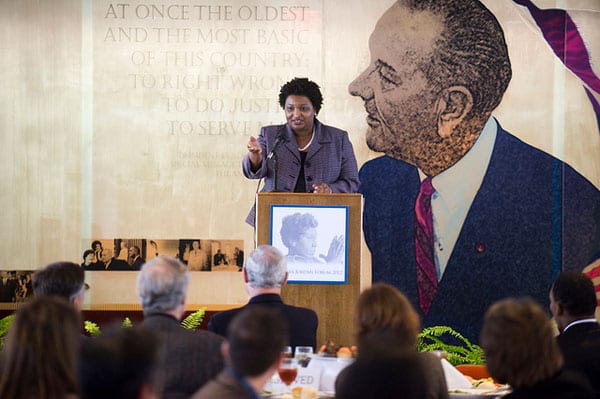
November 6, 2018; Vox
While last night’s blue wave was no tsunami, the gains made on our electoral landscape are both distinct and instructive to the rest of civil society.
Make a note: Leaders of color and issues of marginalized communities are taking center stage, and we must all step up to help center them in our future discourse.
In the context of unprecedented numbers of candidates of color, Andrew Gillum in Florida and Stacy Abrams in Georgia broke new ground in the South with races that were unabashedly progressive. This flies in the face of conventional wisdom, which has held until now that Black candidates in the region must run on a strictly centrist platform. Though he did not win the election, Gillum was the first-ever Black gubernatorial nominee in that state and ran a campaign that acted as a powerful wedge into the future. Abrams still could be the nation’s first African American woman governor.
Race was made so central to this election that trying to ignore it, or not name the social and economic truths it has consistently informed, was impossible. For this, we might thank President Trump for taking such extreme racist positions that they had to be countered straight-on. But, let’s face it, most of the thanks owed go to the young activists who have framed and pursued racial justice in an entirely bold new way that recognizes the power of an unflinching counternarrative and intersectional interests with other marginalized people.
But, lest we believe we have turned any absolute corner, the Washington Post reports that taunting and obstruction efforts heightened as the energy for racial and social justice ramped up on the electoral front. Both Gillum and Abrams were the focus of stomach-turning, racist robocalls, and Abrams was subject to a series of obvious ploys by her sitting-secretary-of-state opponent to manipulate and suppress the vote.
Other advances last night were made in a series of “firsts.” (That these were firsts tells us much about the “stuck” nature of the paradigm and image of leadership in this country.) In New York, Alexandria Ocasio-Cortez will be the youngest woman ever to sit in a congressional seat, and Ayanna Pressley is Massachusetts’ first black congressperson. Minnesota’s Ilhan Omar and Michigan’s Rashida Tlaib are the first Muslim women to be seated in the House. Sharice Davids of Kansas has become the first Native American woman to serve in this country’s House of Representatives.
Sign up for our free newsletters
Subscribe to NPQ's newsletters to have our top stories delivered directly to your inbox.
By signing up, you agree to our privacy policy and terms of use, and to receive messages from NPQ and our partners.
Davids, perhaps, best describes the upsurge of feeling across the country when she says she wants democracy as much as she wants to breathe.
Too many of us have gone through our entire lives not feeling seen and not feeling heard. That is the thing that is going to be the hugest difference between what we had before, and the direction that we’ve seen this country going, and what we have the opportunity to do in this midterm election. We have the opportunity this time to elect people who have been telling you that they want to listen to you, because you should be heard, that they want to see you, because you have to be seen. That is the core of this campaign.
Mark Trahant of Indian Country Today wrote a few days ago that not only is 2018 a record year for Native American electoral candidates, but more of them were women than men. This conforms to a larger picture, in that 2018 has been a record-setting year for women candidates for elected office. All these remarkable candidates of color had a powerful ground game, veritable movements full of activist leaders. Former congressional candidate Denise Juneau comments:
There is a pipeline of people, a pipeline of Native women now that is being built, not just for stepping up and raising your hand, and running for this seat, but also Native women working on campaigns and Native women being involved at central committees, democratic central committees, and Native women finding their place in mainstream politics.
That, she says, is the power that must be drawn through and built on well beyond this election.
As a sector, we are implicated in this potential future. Civic engagement, which had seen a decrease in nonprofit funding over the last decade, has made a sort of comeback, riding the wave of powerful social movements. I hope we are learning our lessons: that supporting civic engagement is a core and permanent strategy for the sector, that this strategy needs strong infrastructure, and that our organizations should be breeding grounds for democratic structures and practices. Now let’s get to work building a more collective future.—Ruth McCambridge











